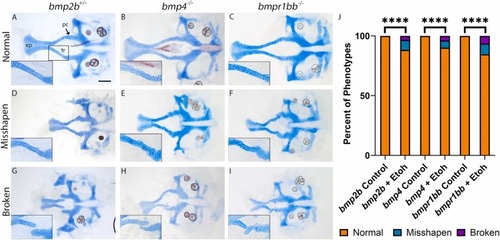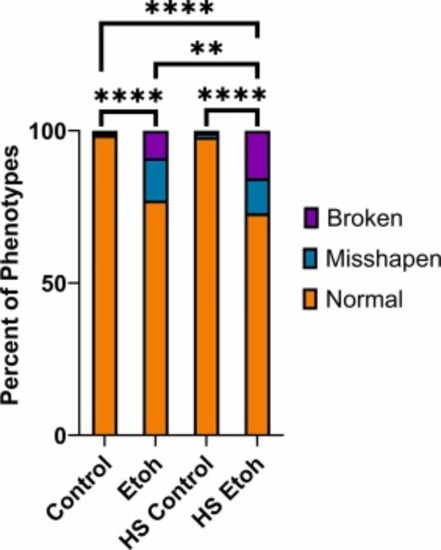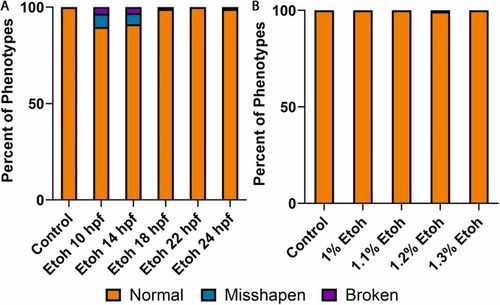|
Multiple members of the Bmp pathway exhibit ethanol-induced palate defects. (A-I) Flat-mount images of neurocranium of 5 dpf larva. Cartilage is blue and bone is red (anterior to the left, scale bar: 100 μm, ep = ethmoid plate, tr = trabeculae and pc = polar cartilage, large images were captured at 10x, inset is 20x image of the left trabecula). (J) total percentage of palate phenotype in ethanol-treated Bmp mutants and controls. (A-C) heterozygous bmp2b or homozygous bmp4 or bmpr1bb mutant larva develop normal neurocranium. Insets show normal stacking of cells in the trabecula. (D-I) Exposure of 1 % ethanol results in a range of defects to palate, from misshapen trabecula (D-F) to breaks in the trabeculae at the polar cartilages (G-I). Percent of phenotypes were quantified and compared for untreated and ethanol-treated larvae for each Bmp component using Fisher’s Exact Test (**** = p <0.0001) (J). “n” for each Bmp component listed in Table 1. PHENOTYPE:
|
|
Upregulation of GATA3 does not rescue ethanol-induced palate defects in bmp4 mutant larvae. Comparison of palate defects in non-heat shocked control and ethanol-treated bmp4 mutant larvae to heat shocked control and ethanol-treated bmp4 mutant larvae. Ethanol exposure results in over 20 % of palate defects in bmp4 mutant larvae. Heat shock induced, upregulation of GATA3 does not rescue ethanol induced palate defects in bmp4 mutant larvae. Percent of phenotypes were quantified and compared for untreated and ethanol-treated larvae for each Bmp component using (two-way ANOVA, F = 57.77, p < 0.0001; pairwise comparisons **** = p < 0.0001, ** = p < 0.005). “n” for each treatment group listed in Table 4. PHENOTYPE:
|
|
Expression of gata3 is unaltered in ethanol-treated bmp4 mutant embryos. (A-D) Whole-mount, confocal images of bmp4 embryos fluorescently labeling gata3 gene expression at 36 hpf (lateral views, anterior to the left, scale bar: 100 μm). Arrows show normal expression of gata3 in the maxillary domain of the NCC in untreated and ethanol-treated wild type and bmp4 mutant embryos as well as ethanol-treated wild type embryos (n = 10 embryos per group). EXPRESSION / LABELING:
|
|
Timing and penetrance of ethanol sensitivity in bmp4 mutant larvae shows that palate defects occur when exposure is from 10 to 18 hpf. (A) Comparison of palate defects in bmp4 mutant larvae when ethanol exposure is initiated at 10 hpf, 14 hpf, 18 hpf, 22 hpf or 24 hpf. Ethanol exposure results in approximately 10 % of palate defects in bmp4 mutant larvae when ethanol exposure is initiated at 10 or 14 hpf. Ethanol exposures initiated at 18 hpf or after does not result in palate defects. "n” for each treatment group listed in Table 5. (B) Comparison of palate defects in bmp4 mutant larvae with increasing ethanol exposure doses initiated at 24 hpf. Increasing ethanol concentrations, from 1 % to 1.3 %, initiated at 24 hpf do not result in palate defects. “n” for each treatment group listed in Table 6. PHENOTYPE:
|
|
Dorsomorphin-treated larvae show palate defects but normal gata3 expression when treated between 10 and 18 hpf. (A) Comparison of palate defects in DM-treated larvae with expanding DM exposure window from 10 to 11 hpf out to 10–18 hpf. We observed a large number of palate defects with a DM exposure window as short as 2 hours, 10–12 hpf with increasing duration of exposure resulting in consistent palate defects. (B) Comparison of palate defects in DM-treated larvae with increasingly later initiation time points of DM, 14 hpf (consistent with the latest exposure initiation of ethanol at a higher penetrance (Fig. 4A) out to 30 hpf. Consistent with the ethanol sensitivity exposure window, the percentage of palate defects decreases drastically when DM exposure is initiated at 18 hpf. “n” for each treatment group listed in Table 7. (C,D) Whole-mount, confocal images of DM-treated (10–18 hpf) or DMSO control embryos fluorescently labeling gata3 gene expression at 36 hpf (lateral views, anterior to the left, scale bar: 100 μm). Arrows show normal expression of gata3 in the maxillary domain of the NCC in DMSO and DM-treated embryos as well as ethanol-treated wild type embryos (n = 7 embryos per treatment group). EXPRESSION / LABELING:
|
Reprinted from Reproductive toxicology (Elmsford, N.Y.), 131, Lovely, C.B., Bone Morphogenetic Protein signaling pathway - ethanol interactions disrupt palate formation independent of gata3, 108754, Copyright (2024) with permission from Elsevier. Full text @ Reprod. Toxicol.





